Bayern Munich have dominated the Bundesliga over the past decade, leaving little chance for the other teams to compete for the title. Borussia Dortmund, Bayer Leverkusen and RB Leipzig have had their time in the spotlight as well, settling a pretty consistent top-four in the premier German tier.
However, Union Berlin shifted the scene with their consistent strategy and constant improvement, steadily building their way through to the most desired part of the table. Joining the league for the first time in their history in 2019 was surprising enough, but no one thought they could transform into title challengers in just a few seasons.
Their manager, Urs Fischer, achieved that through consistency and hard work and built a team with a recognisable style of play that know how to calculate the risk and gain an advantage from it.
Die Eisernen have minimised their weaknesses but still have a lot to improve on if they want to settle as a big team and threaten Bayern’s 10-season streak.
The team stick to what they do best and rarely shift tactics, but their constant improvement in these areas and the rotation of the starting XI allow them to still be unpredictable and efficient.
In this tactical analysis we examine their tactical evolution in the Bundesliga in the form of scout report.
Current season dynamics
At the time of writing, Union Berlin are sitting third in the table, largely thanks to their impressive defensive performance. While they are followed by RB Leipzig and Freiburg, their well-measured defensive actions have resulted in having the second-best defence in the league. That makes the difference and gives them an advantage as their actions in attack are much more limited compared to their competitors.
As mentioned, the team often rely on calculated risk and prefer to be the more passive side, inviting pressure and controlling the game out of possession. Since their attacking strategy is very straightforward with an underlined preference for playing wide and counter-attacking, they prefer waiting for the right moment to strike. That’s why the focus goes on their performance without the ball and their defensive positioning and interactions.
The way the team manoeuvre and employ their mid-block allows them to control their opponents’ movement and utilise the chances from both provoked and unprovoked mistakes that they make. The focus on their defensive actions has led to conceding only 31 goals so far and helped them score six goals on a counter.
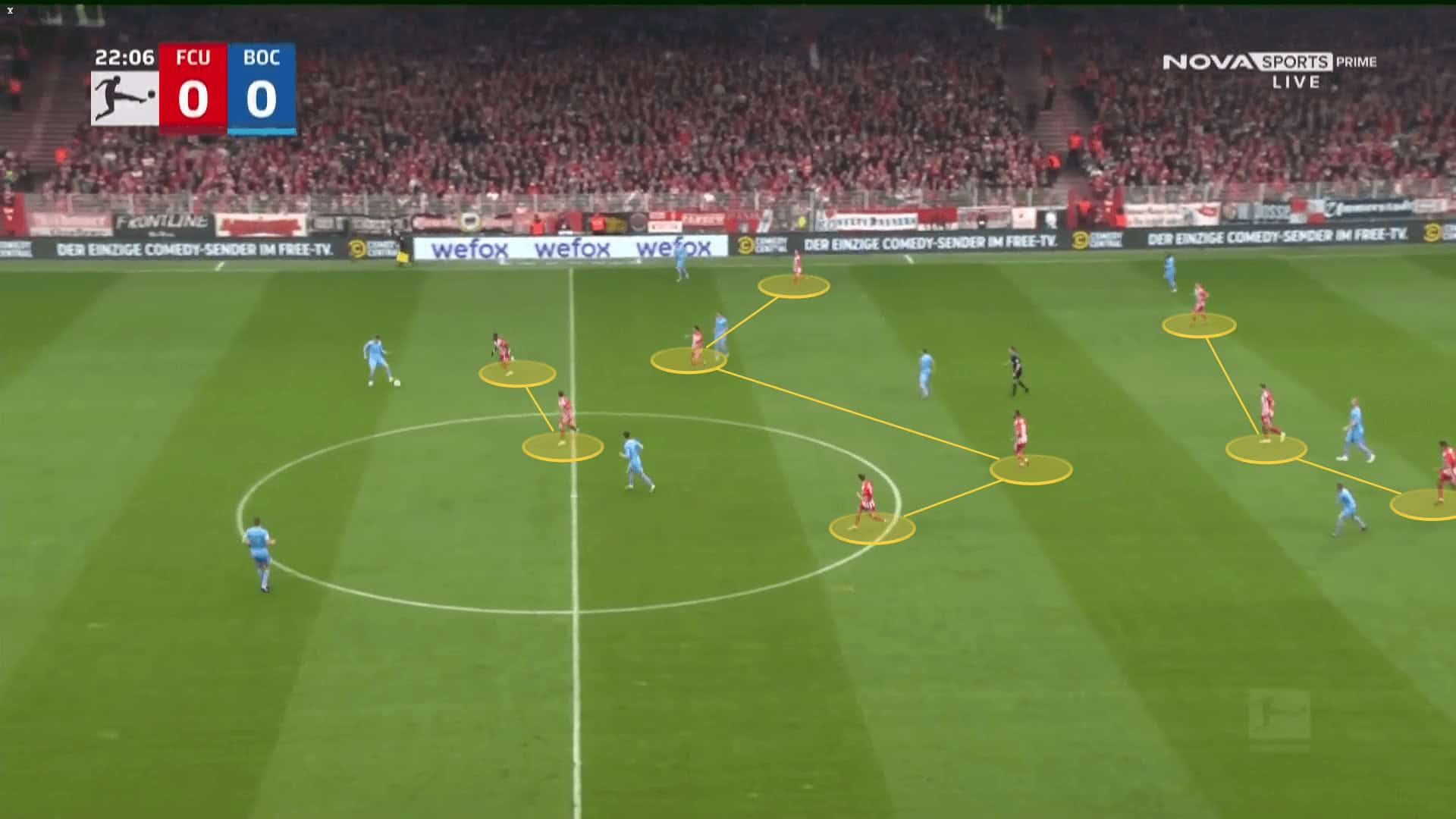
Their pressing strategy allows them to effectively disturb the opposition and makes it very difficult for them to penetrate in their usual style. According to their PPDA rate (14.6534), Union’s press intensity is the second-highest, which may lead to the false impression that they don’t put any effort to win back the ball.
However, that is misleading as the team allow the opposition more time on the ball per defensive action but do limit their movement through their positioning. In fact, their willingness to interrupt their opponents’ build-up through well-measured movement off the ball and bold counter-pressing reactions makes them this successful defensively.
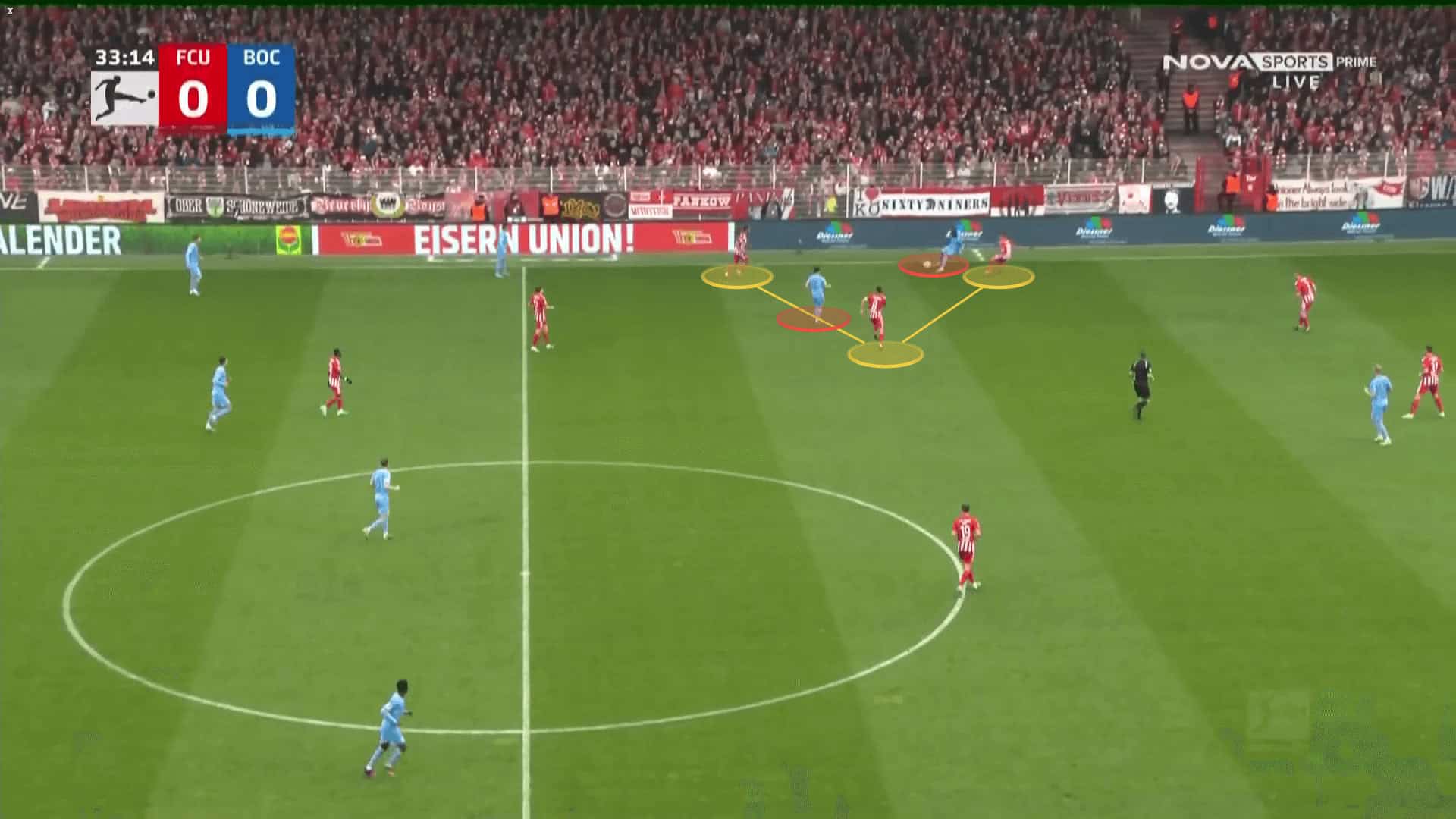
While they are less productive in attack, they still manage to do their job, avoiding unnecessary movement and relying more on delivering the ball to the advanced areas through direct play. The team don’t rely on creativity and retaining the ball in the final third through short pass combinations and high possession percentile. Instead, they try to expose their opponents through the wings, relying on playing wide and delivering the ball centrally through crossing.
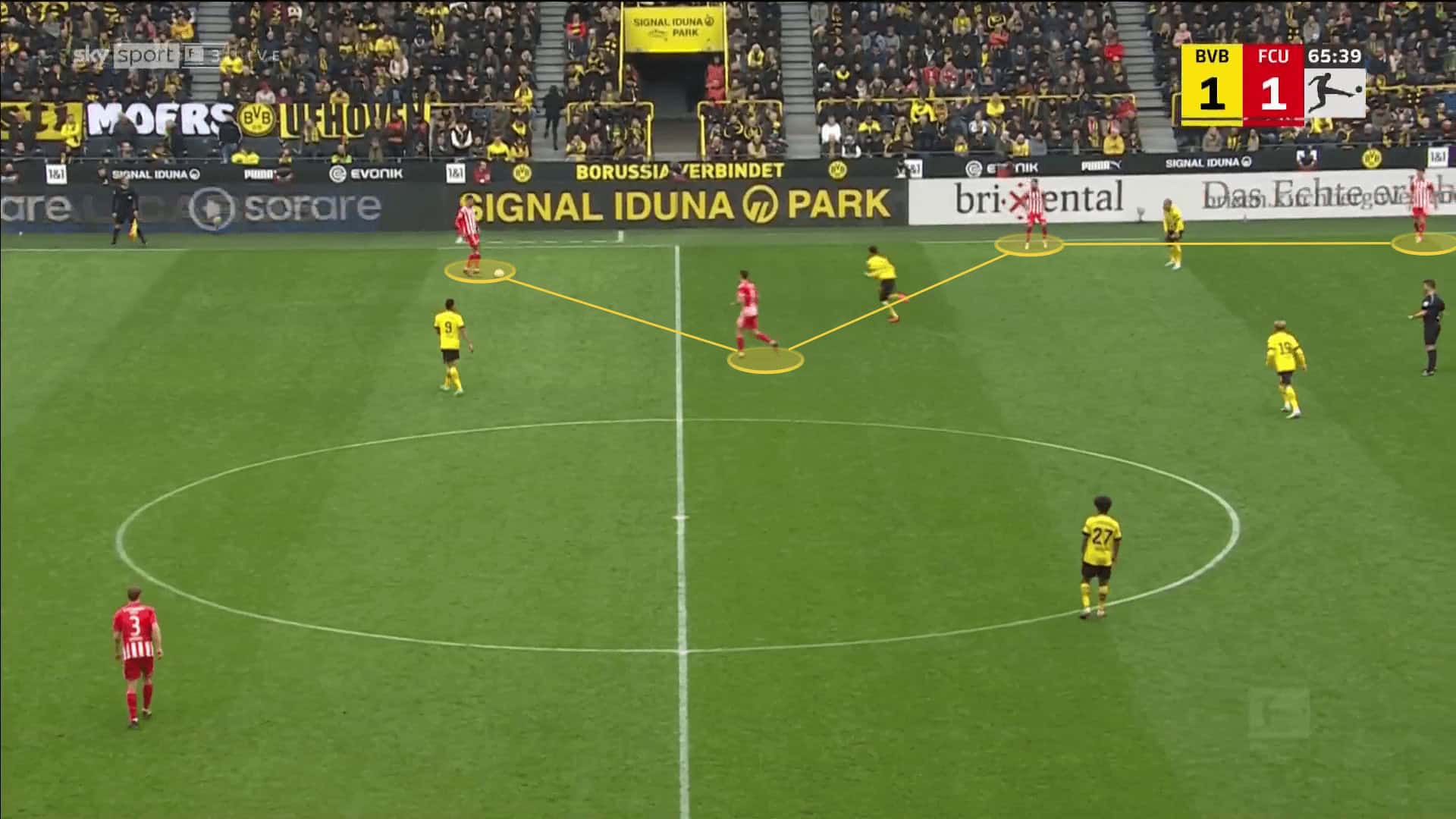
They constantly try to improve on their strengths in attack, instead of trying to be versatile and risk losing momentum. And it has proved successful so far. The team have the highest cross-accuracy percentage (41.5%) among all teams in the top five European leagues and have scored most of their goals thanks to that feature.
Their other weapon is counter-attacking. Fischer’s side rely a lot on ball recovery through their pressing, as mentioned, which often allows them to catch the opposition off-guard and expose them using pace and strong positioning. They always try to have a few players behind the ball so they can quickly transition should they recover possession. That helps them in advancing the ball through quick short passing and dispositioning the opposing players.
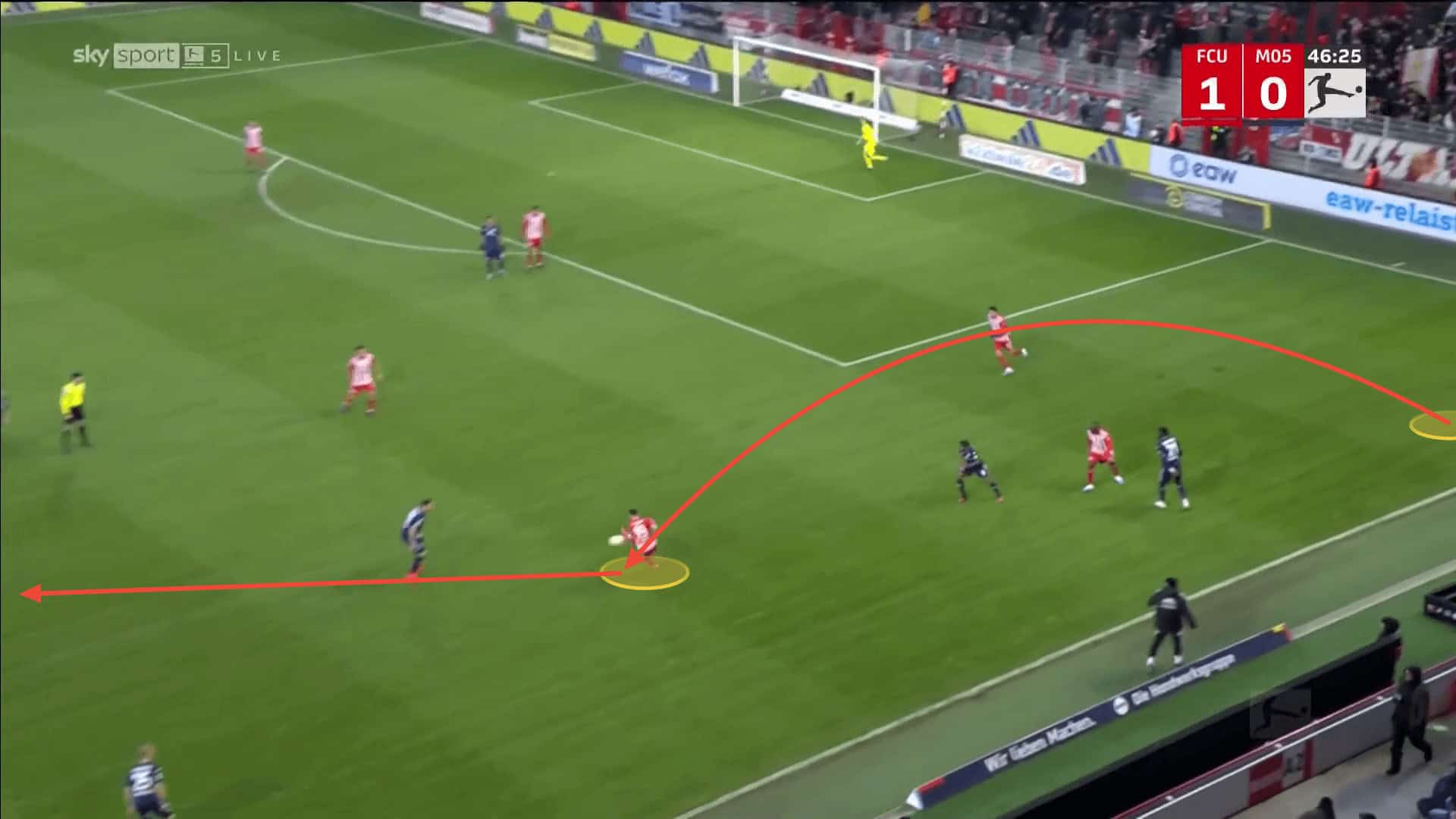
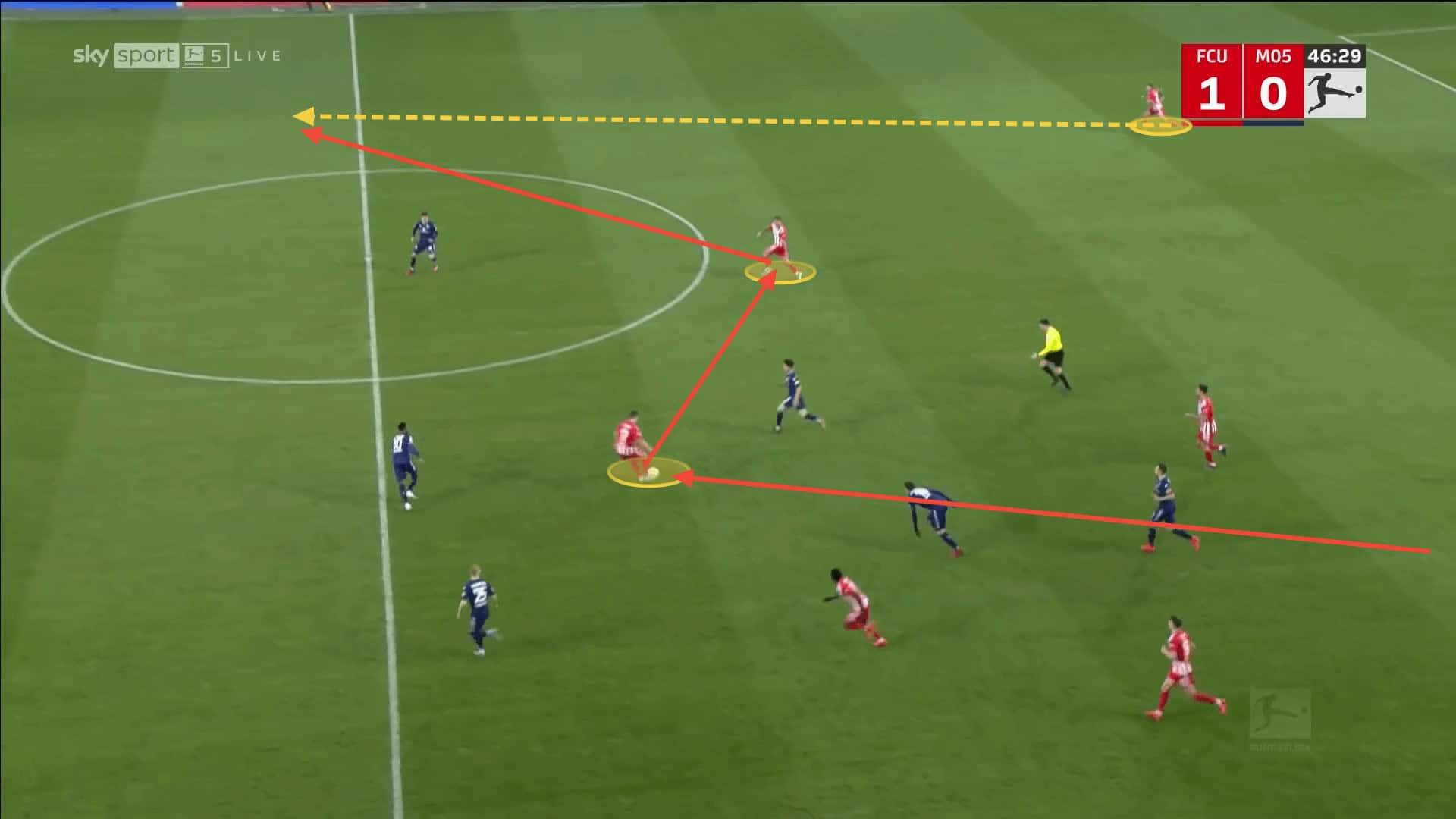
Instead of changing tactics, the manager relies on the change of personnel and rotates the starting XI. This allows Union to retain the unpredictability and make slight adjustments through the players’ abilities. This still works for keeping their opponents on their toes and succeeding in their attacking actions. However, he needs to create a plan B as the league becomes more and more competitive and they might not be able to stick on top for a longer period as their numbers in possession are not improving proportionally.
Union’s biggest strength in the 2022/23 season is their attacking set-piece performance. The team have scored 15 goals from set-piece opportunities at the time of writing, most of them being a result of their distinguished crossing and strong positioning in the penalty area. Their success from set-plays underlines that despite not being versatile in their build-up and movement in the final third, the team is looking for different ways to expose the opposition.
Their defensive approach comes with its pros and cons, though. Fischer’s side commit a high number of fouls per game, which often results in giving away goalscoring opportunities in key areas. Inviting pressure and focusing on their defensive actions results in 12.3 fouls per 90 which have cost them conceding six goals from set-pieces so far.
How have they developed in the Bundesliga?
Ball progression
One of the most prominent reasons for Union’s successful performance in the Bundesliga is the consistency of their approach throughout the years. Fischer has relied on the same tactics since their promotion in 2019 and only tries to make small twitches to initiate improvement and make the team competitive enough.
The team’s ball progression movement hasn’t changed much over the past four seasons. The team have always been moderate in terms of pass frequency, trying to retain possession at the back and build up from there.
They would usually spread out wide and rely on short pass combinations on the flanks right until they are in a good position to cross. The below pass maps show comparison between their movement in 2019/20 and this season.
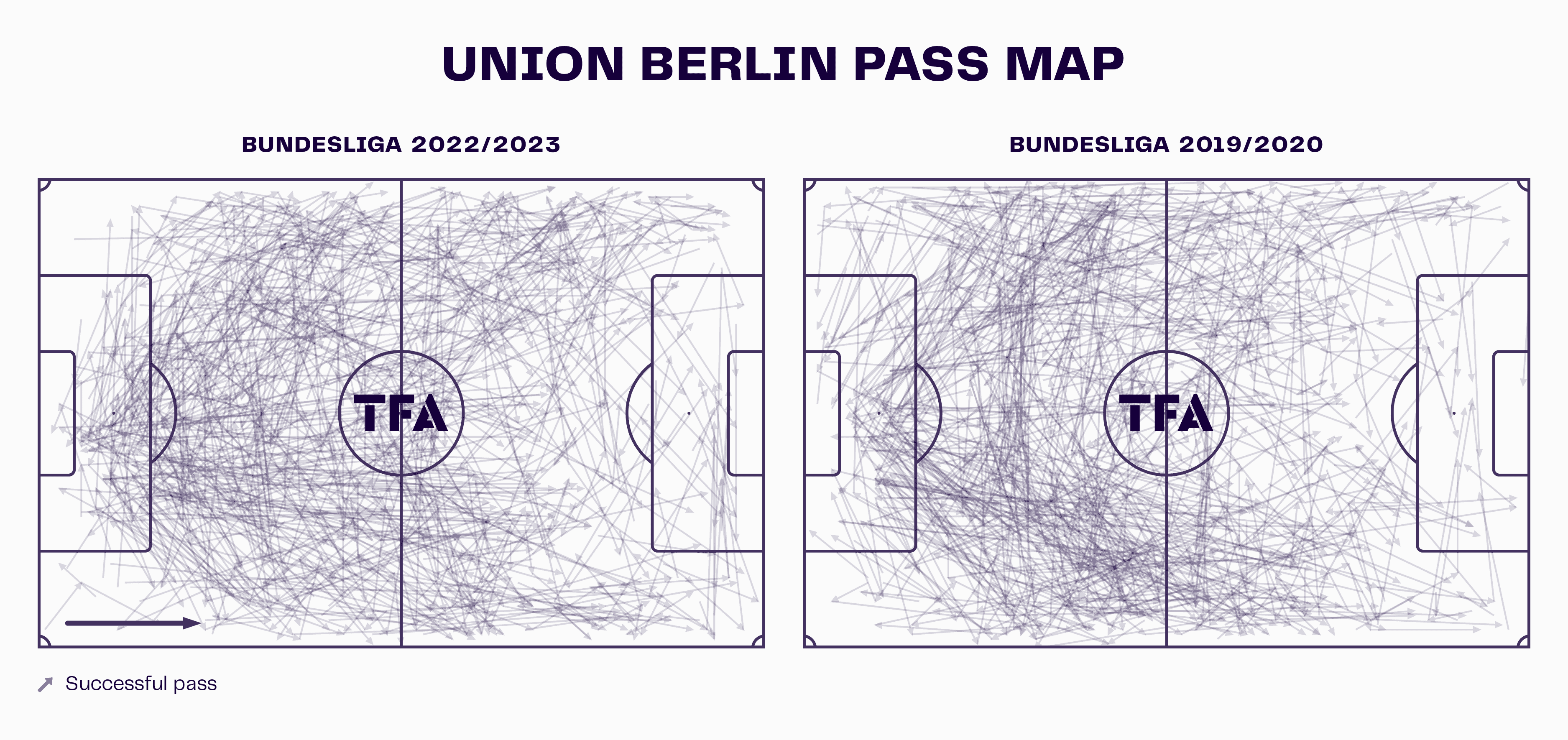
They underline the consistency of their approach but also show the evolution of their passing and how they cover more areas now. The team have become even more active on the flanks, while they also have slightly better coverage centrally.
Union are not a possession-based team. As mentioned, they often prefer giving away the initiative and inviting pressure, resulting in being third to last in the league in terms of possession percentile (43.6%). That’s why they have chosen to be more straightforward and pragmatic in their build-up-play. Once they have the ball, they try to shift it forward as quickly as possible. Their direct play results in a high frequency of long balls. That’s something they have tried to improve on increasing the accuracy of the passes as well.
The pragmatism in their approach results in decreased numbers of dribbling attempts and progressive runs in their build-up throughout the years. They prefer to shift the ball quickly to the advanced areas, rather than relying on players to progress with it. This is underlined by their counter-attacking movement as well, where they don’t use one player to progress the ball but instead stick to short passing.
Their strategy has been successful since it dispositions the opposing players and disallows them from dropping back in a structured manner. Fischer sticks to his favoured 3-5-2 formation each season so it allows the team to defend effectively with five men, but also have the required support on the flanks so they can make quick transitions.
Attacking strategy
Die Eisernen haven’t changed much in attack either but the areas they improved on have proved crucial for their movement up the table. They have always relied on high pass frequency. After their first season in the Bundesliga, they have slightly improved the frequency of their attempts, which gives them more opportunities in attack. But what makes the difference for them is the constant improvement in terms of accuracy.
The team’s cross-success rate has increased from 33.1% in 2019/20 to an impressive 41.5% in the current season. That makes them the most successful team in that area in the top five European leagues. This has resulted not only in scoring more goals but also in outplaying their xG numbers.
They have managed to balance out both flanks and have the same success rate crossing from left and right. This makes it even more difficult for their opponents to cover them and focus their defensive actions in certain areas. The team started to rely on the switch of play more often as well, which frees some space and makes them even more successful in their crossing attempts.
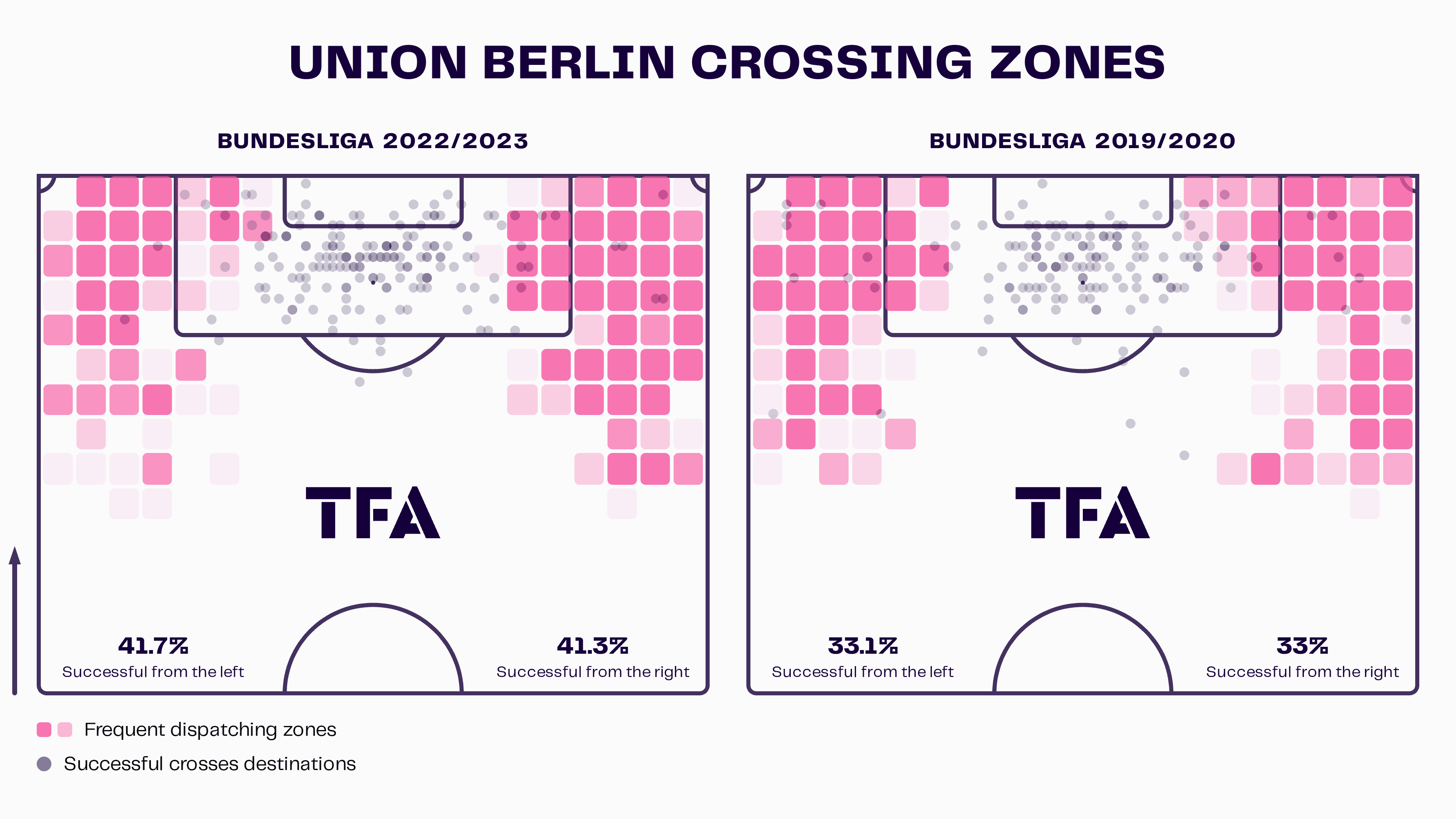
That improvement results in scoring more headers each season. The combination of crossing and their improved positioning in the box makes it easier for them to expose the opposition through heading attempts. The team have scored 12 headers so far this season. Their success in these attempts is crucial due to their lack of movement in the box. Union have some of the lowest numbers in terms of touches in the penalty area as they prefer delivering the ball through crossing or long balls and directly shooting, instead of making pass combinations centrally. That has always been the case for them.
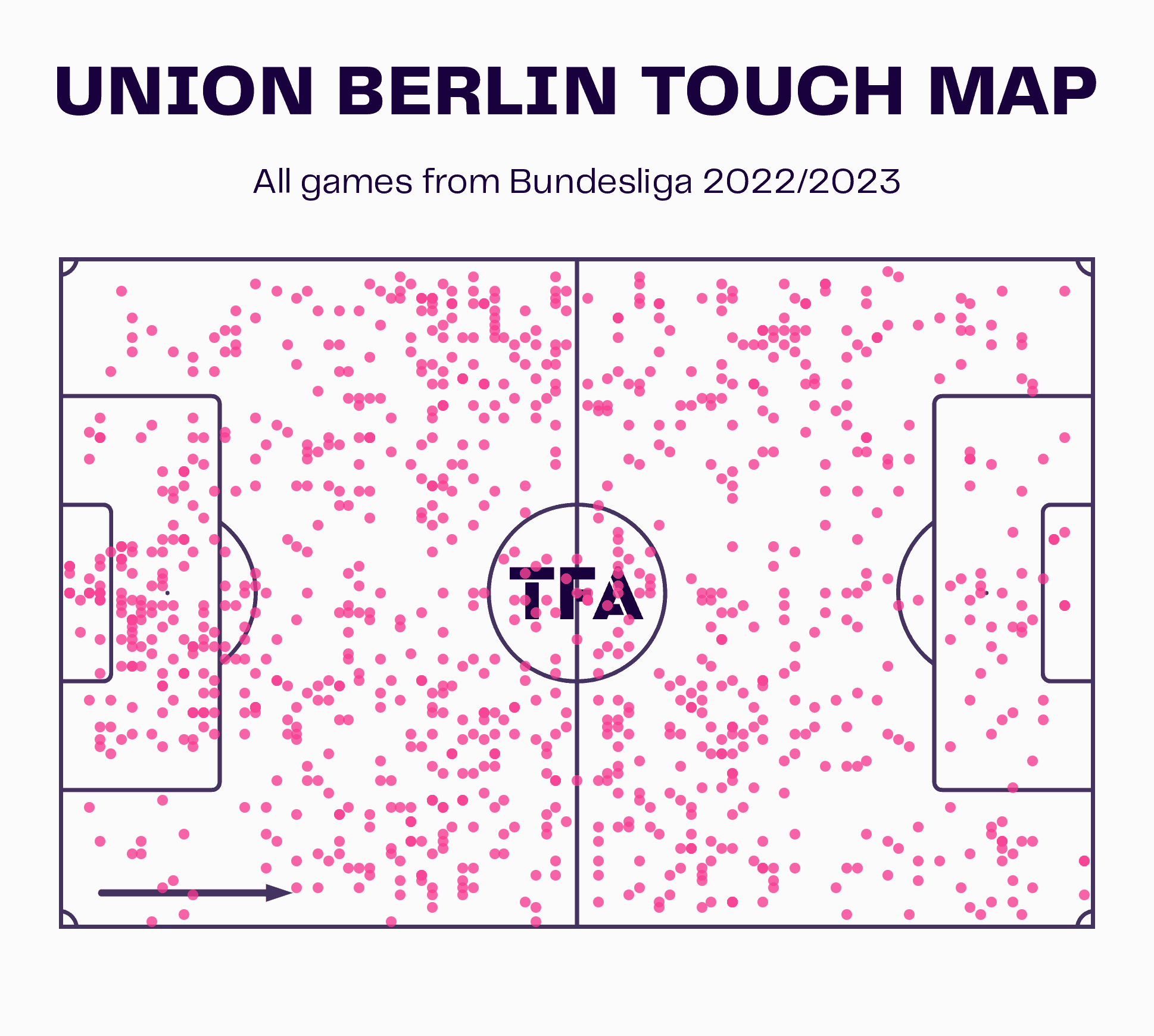
The aforementioned is the main reason for the density of shots from the central areas of the box, as shown in the map below. Another noticeable difference is in the shots on target category. Despite having fewer attempts on target, their goal success rate has improved immensely. The team have had different success in their shooting activity throughout the years. While they had more attempts per 90 and a higher percentile of shots on target, the conversion rate was lower, compared to the current season.
They have never been among the most productive teams in front of the goal due to purposely giving away the initiative and staying in their mid-block. They do this so they have better opportunities to counterattack, relying on their pressing efforts and ball recovery. Another aim is to mislead their opponents that their control the game and take advantage of their mistakes.
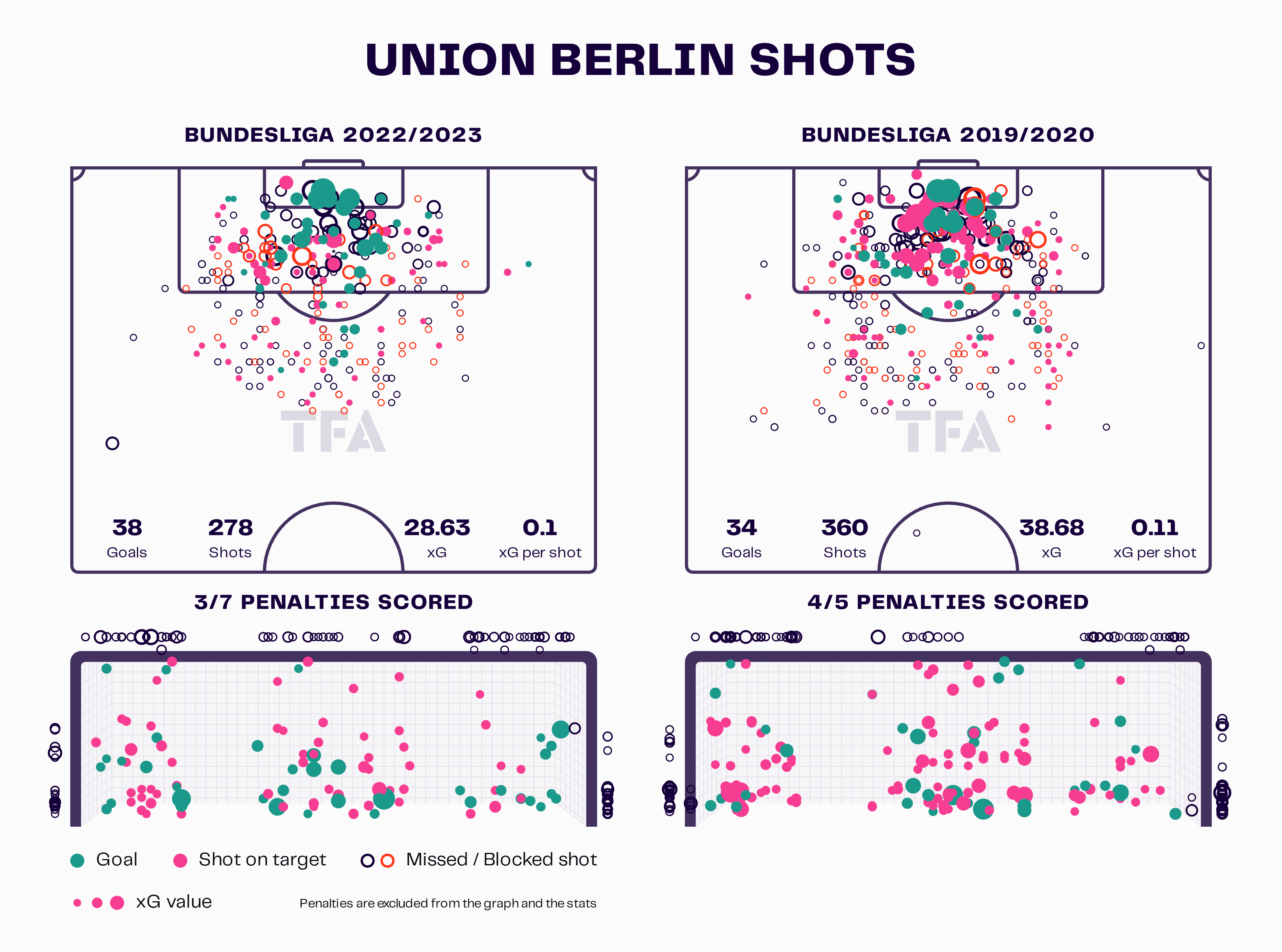
The team have shown consistency in multiple areas in the last four seasons, which is the key to their success. While it is key to seek improvement and do little tactical twitches, their strength has proven to be not neglecting some areas while working on others.
They haven’t decreased the number of shot attempts from distance at the expense of crossing, which has served them well, as the team score seven goals on average per season from outside the penalty area. That’s often thanks to their counter-pressing efforts as they take on their opportunities from ball recovery centrally.
The main area that was affected by their improved cross accuracy is their success in corners. That’s actually key for their improved numbers in the attacking set-pieces. The team have scored 10 goals from corners in 28 games, twice as many as the entirety of last season (five).
Pressing efforts and defensive approach
Union have come a long way in their pressing performance. As mentioned, their PPDA rate of 14.34, doesn’t show the real effect of their efforts.
Their goal isn’t to increase their time on the ball, so they do not dive into defensive challenges too quickly. Instead, they prefer to apply pressure through their positioning and force the opposition into mistakes, which can result in losing the ball or at least kill their opponents’ momentum and keep them away from the goal.
Their pressing strategy results in an improvement in other areas. And that’s exactly what Union aimed for. The team have increased their ball recovery numbers. From an average of 84.59 in their first season in the Bundesliga, to 90.86 recoveries per 90 this season. The different areas where they attempt to recover the ball, serve them different purposes.
They achieve a high number of high regains through intense counter-pressing, which disrupts the opposing defences and gives them chances to do quick turnovers. As shown on the map below, many of their recoveries in the final third have resulted in producing a shot within 20 seconds.
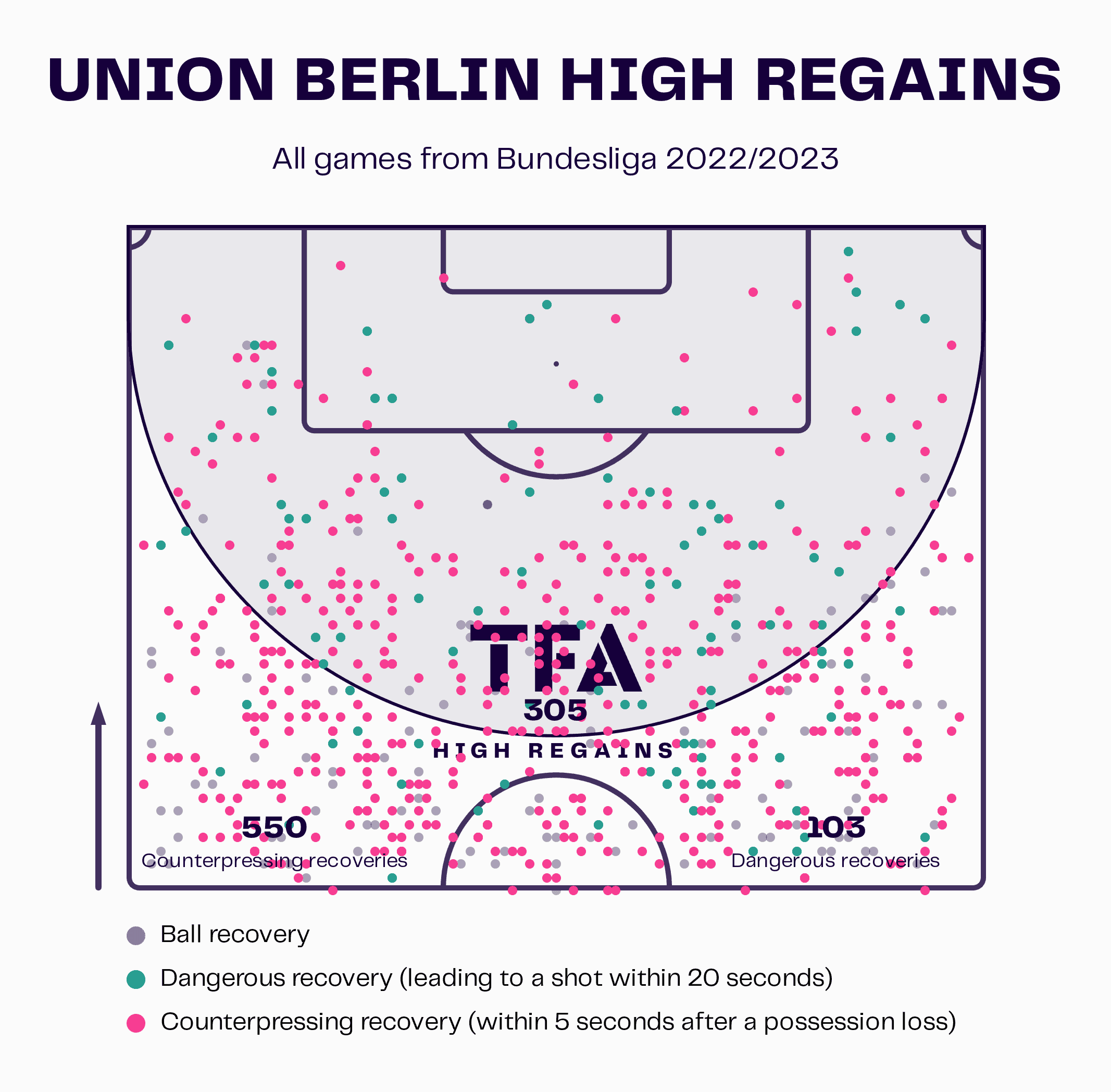
Sitting in their mid-block allows them to successfully interrupt the opposition’s build-up and have enough space behind to play the ball out wide once they recover it. This gives them the chance to create goalscoring opportunities through crossing.
Their pressing efforts also help them in keeping the ball away from their goal, which is one of the main reasons for having the second-best defence in the league. However, this is a highly risky approach and has some negative effects on their performance as well. While they continue to master it and it currently has more pros than cons for them, it can lead to some errors in the future.
Their pressing and occupation of their own half often result in committing fouls. Union are third in the league in terms of committed fouls per 90 (12.3) which is likely to lead to giving away set-piece opportunities and penalties. Inviting pressure goes hand in hand with playing on the edge and being prone to defending more harshly. It also expectedly increases the risk of losing the ball in dangerous areas. That’s actually something that they still have to improve on, as they frequently concede shots from lost balls in the box.
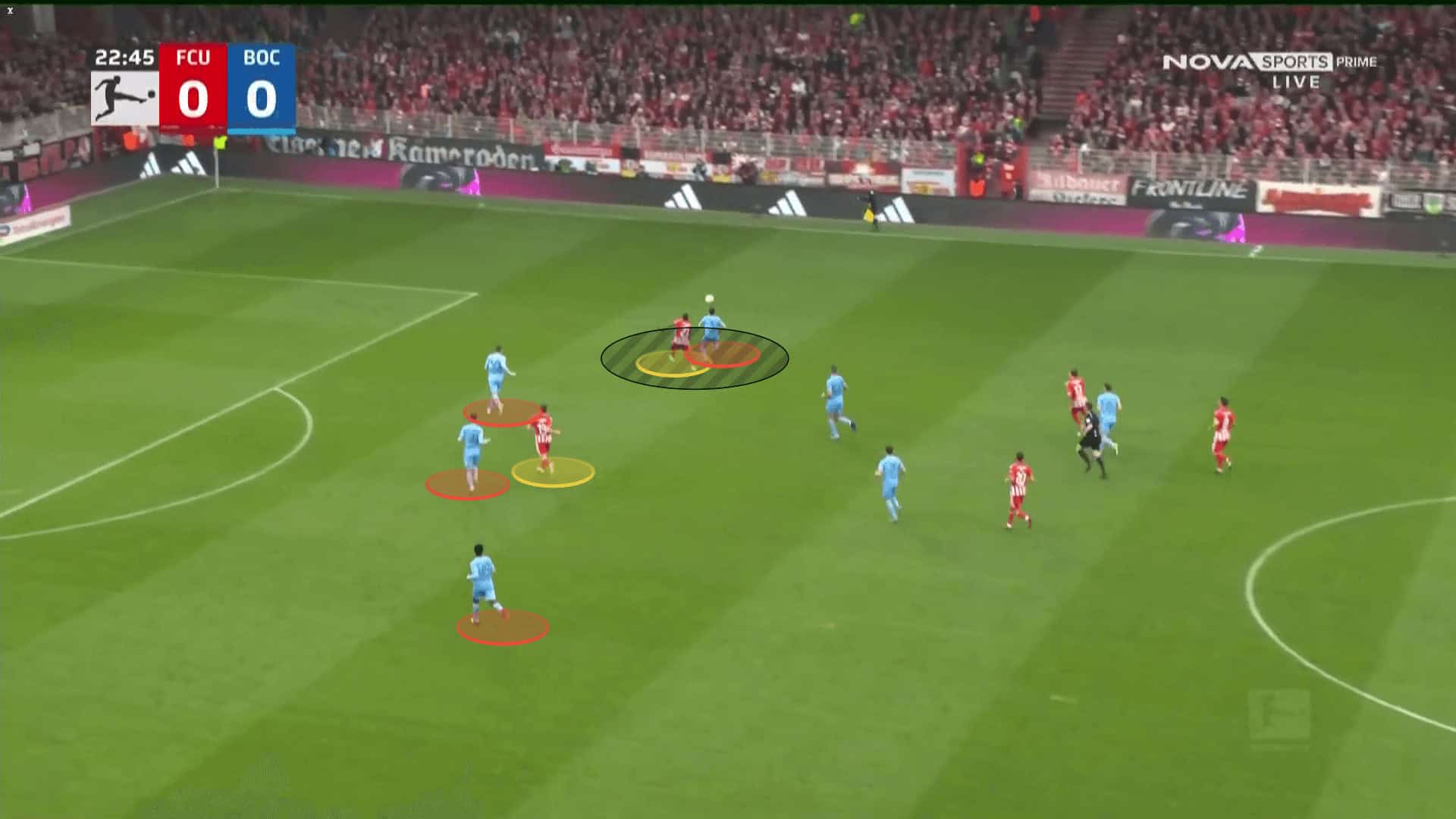
The team’s low success in aerial duels also affects their defensive record. The team have conceded five goals from penalties and six goals from set-pieces in 28 games.
What can be done better next season?
The first and foremost task for them to do even better next season is maintaining their consistency. They have achieved that successfully in the past seasons and it will be crucial for them to stick to their strengths even more.
However, that won’t make a big difference if they don’t try to improve their weaknesses and minimise their mistakes. Although their pressing defensive approach has calculated risk and gives them a lot of room in attack, Fischer needs to find a way to decrease the number of foul plays, especially in their own half.
This can happen by advancing the team and focusing more on high pressing and shifting from their mid-block more often. They have proven to be successful in recovering the ball in the opposition’s half, so moving up higher might be a good way to decrease the pressure on the defence. They would be able to still control the game out of possession but have better success at keeping it away from their defensive third and having to rely on harsh defensive interactions.
Of course, this approach should be considered and implemented carefully, as the team do get easily exposed on a counter and having a higher defensive line will increase that risk. However, the risk of this becoming a tendency might be lower than committing fouls and losing the ball in their own half.
The improvement of their aerial performance is highly required as well. It will help them narrow down their exposure to their opponents’ set-piece chances and crossing attempts. Their defenders do have the needed height to be competitive enough in the air. However, the technique and timing are something that should be worked on, as Union’s defenders have some of the lowest aerial duels success rates compared to the other top teams in the league.
Currently, they are doing just enough in attack to stay in the top positions, but their overcommitment to crossing sometimes kills the momentum and deprives them of creating quality goalscoring chances created through the central areas. They are programmed to always find a way to spread out wide, which sometimes results in missing a player in a good position centrally.
Trying to increase the smart pass frequency and looking to exploit more tight spaces there could be beneficial for the team in increasing their shot frequency and accuracy as well.
Final thoughts
As our analysis shows, Urs Fischer has built a well-balanced team, who can play on the edge and yet be confident enough to succeed in each phase of the game. If Union retain their consistency and continue with their steady improvement, they can surely settle as one of the top teams in the Bundesliga and participate in the European tournaments on a yearly basis.






Comments